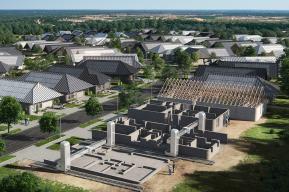文章
人类世:科学辩论的重大挑战

“人类世”(Anthropocene)一词的产生是用以考虑温室气体的加速积累对气候和生物多样性产生的影响,以及对自然资源的过度消耗所造成的不可逆转的破坏。但我们是否需要将之划为一个新的地质时代?科学家们对此仍在辩论,解决方案尚有待探寻。实际上,我们正在目睹一种集体形式的否定,这是由对进步、消费主义意识形态和强大的经济游说团体的轻信所致。
莉茲-雷雅娜 • 伊斯贝内,菲利普 •利纳
“人类世”一词如今大行其道,有其出现在标题中的著述和科学文章数以百计,引文数以千计,媒体报纸对它的使用也越来越频繁。该词最早由美国生物学家尤金·施特默(Eugene Stoermer)于20世纪80年代创造,荷兰大气科学家、1995年诺贝尔化学奖获得者保罗·克鲁岑(Paul Crutzen)于21世纪初予以推广,用来指称人类行为开始引起全球性生物物理变化的时代。他们注意到,在这些变化的引导下,地球系统日渐偏离了自1.17万年前全新世开始以来一直保持的相对平衡。他们提议应将这个新时代的起始年份定在具有象征性意义的1784年,因为这一年苏格兰发明家詹姆斯·瓦特(James Watt)创造了新的发明,对蒸汽机作了重大改进,而且时间上也与工业革命的开始和化石燃料的使用同步。
自1987年到2015年期间,规模庞大的多学科研究项目“国际地圈—生物圈方案”(地圈—生物圈方案)收集了大量有关地球系统人为变化的数据。此外,始于20世纪50年代,以美国夏威夷莫纳罗亚天文台所分析的南极古老冰芯样本信息和当前大气组成为基础开展的其他研究表明,温室气体,特别是二氧化碳,正在加速积累。1987年,政府间气候变化专门委员会(气专委)成立,旨在评估这些现象对气候的影响。
大加速
环境科学家约翰·罗克斯特伦(Johan Rockström,瑞典)和威尔·史蒂芬(Will Steffen,美国)及其在斯德哥尔摩复原力中心的同事们曾先后于2009年和2015年两度汇总上述研究数据,编制一份表单,列出了九大慎勿逾越的地球生命底线。如今其中四条底线已被逾越——气候变化、植被覆盖、生物多样性减少和灭绝(第六次灭绝)以及生物地球化学流——其中,磷和氮循环起着尤为关键的作用。他们还向世人证明,自第二次世界大战以来,关于初级资源消耗、能源利用、人口增长、经济活动和生物圈退化的所有现有指数全部暴增,并将这段时期称为大加速。更有其他观察人士直言,20世纪70年代至今的这段时期堪称超加速期。这些趋势均被认为不可持续。
是隐喻还是真实的地质时代?
地球系统若干参数近来的发展已经开始超出全新世自然变异的范围,这一点似乎已成共识——现在,用“人类世”这一术语来说明人为变化或多或少已为人们所接受。然而有少数科学家决定更进一步,不再仅以隐喻的形式使用该术语或仅将之用作一项实用的跨学科参考工具。他们提出,应当把人类世正式提升到地质时代的位阶,与全新世和更新世平起平坐。
一个人类世工作组为此而专门成立,把这一提案介绍给国际地质科学联合会。但就地层学家命名一个新时代而言,须得在两个时代的沉积层之间发现明显可见的、普遍断裂才行。自19世纪50年代以来,人们已注意到沉积物中存在着人迹碳,但认为这不足为凭。因此,人类世工作组建议将时代变更的时间点定在1950年,即最初在沉积物中发现各种人造化学成分和塑料颗粒的年份,也是大加速的开端之年。无论如何,即使不能将人类世认定为一个地质时代,也绝不妨碍科学界依当前状况使用这一术语。
人类世这个概念问世时间虽短,却已数度引发争议,术语本身也受到质疑。历史学家和人类学家质疑提及anthropos(一般人)。逾越生物地球物理底线的责任不在于西方人和某种特定的社会经济制度,那又究竟在谁?针对这一问题,又有其他若干提法陆续出炉——西方世、资本世等。其他人,例如全球或环境历史专家等,则认为,根本不存在本体论不连续性,而且西方增长性质特殊(大分化) ,有待在更长的时期内重新加以定位。
他们还表示,至少在过去四万年中,人类对周围环境的影响一直不断扩大。例如,人类对美国和澳大利亚巨型动物群的消失就难辞其咎。因此,某些研究人员力主,人类世历史漫长,其中包括资本主义工业化(1850—1950年)和大加速等多个子时期。然而,大多数人已经认识到,在划分历史时期的问题上,有必要摒弃线性和决定论思维。
第二次世界大战结束以来,若干科学家就警告称,西方经济模式不可泛化,不可持续。至今底线尚未逾越,人类消耗亦未超过一个星球的负荷,但是这个进程已经开始了。到20世纪70年代初,情况恶化,警告倍增,科学数据不断累积。在这两个交叉节点,进程本有可能发生历史性改变,然而时至今日,已是难上加难。
集体否定
我们究竟为何不愿看到这样?原因可能有很多:盲目相信进步和发展,换句话说就是盲目相信让现有财富无限增加的制度,以及相信科技能够解决所有问题,消除所有外部负面影响(如污染等);强大的利益集团从这一进程中获利并大力进行游说;媒体主宰了消费者思想,激发了个人消费欲,也同样激起了贪图安逸舒适,以求与众不同,获得认可的欲望。
这个问题将决定人类的未来,而人文社会科学长期以来却一直对此避而不谈,这着实令人惊讶。这些学科除了明确以人类为中心的定义外,还认为这是一个典型的自然科学领域。但人类世概念的横空出世,赋予他们一项责任,那就是必须解释人类社会何以能够让我们这颗如此巨大的星球的运作模式发生变化?人类社会又将会在世界版图上产生怎样的差异化影响?社会科学和人文科学应该不断向前发展,不断创立新学科、获取新知识,以解答这个新时代提出的种种问题,包括自然灾害、可再生能源、自然资源枯竭、荒漠化、生态灭绝、大范围污染、移徙,以及社会和环境不公正。
政治家和整个社会对气候变化的反应迟钝且微弱,这也令人愕然。一项对引文网络的数学分析表明,关于这个专题的科学文章有一项共识,即自20世纪90年代初就存在着气候变化。鉴于这场危机在不断恶化,实在很难理解减少温室气体的努力如此三心二意究竟是为何故。是何种障碍在拖低国际谈判的成效?除了这些所谓障碍的有意设置之外,科学与社会之间无疑沟通不力,至少在气候问题上是这样。为了解决这个问题,气专委改用新方法编制第六次评估报告,旨在提高广大公众的认识水平,不只是决策者的认识水平。
打破僵局
人类世前的一块绊脚石是,要想解决人类世问题,就必须先处理环境正义这块烫手山芋。气候变化不仅会放大自然和人类系统的现有风险,还会带来新的风险。然而,这些风险并非平等分布,通常都是弱势个人和群体首当其冲。但鉴于各国在发展水平、国土面积、人口规模和自然资源等方面存在差异,要找到令人满意的解决办法绝非易事。
不仅如此,人类生态足迹已经超过我们这颗星球再生和吸收能力的50%,并且地球80%的人口生活在生物承载力业已小于生态足迹的国家。巴西(以及美洲大陆上的其他国家)等国家尽管已消耗1.8颗行星的资源,但仍拥有巨大的生物承载力盈余。不过,该国温室气体排放量的26%要归咎于森林砍伐。该国很大一部分生态足迹来自于初级产品出口,这是导致上述大部分森林被砍伐的原因。竞争激烈的全球化体系设法以最低的成本取得供应品,由此助长了许多国家的资源榨取主义和一些国家的土地掠夺之风。
即便现在有可能抑制高收入国家所有二氧化碳的排放,也依然不足以减少全球碳足迹,并在2050年之前达到为生物圈设定的二氧化碳排放量限值。换言之,尽管各国经济规模和自然资源储备迥然有异,但所有国家都需努力通过大幅减少本国温室气体排放量以补救人类世最为紧迫的问题。
这正是导致我们陷入常有的国际谈判僵局的原因,寻找罪魁祸首会有碍各国作出承诺,唯恐影响本国经济增长和就业,或触怒强大的利益集团。2016年4月22日签署的《巴黎协定》所达成的解决方案是请各国作出自愿承诺,而不是强硬推行在全球基础上确立的标准。也就是说,各国可承诺实现其认为可行的减排目标。
这种做法有助于克服僵局并落实行动,但它制造了混乱不堪的评估标准,使比较各国之间所作的努力变得复杂。而且,《巴黎协定》虽具有普遍性,但未规定对不履行承诺的国家进行制裁。这说明气候问题治理不力,在没有机构受权代为治理的情况下,气候问题根本无法凌驾于国家和企业的经济利益之上。
在矛盾、难题和无知三座大山的重压之下,人类世极其严重的环境问题在国家和社会议程上无法获得所需的优先级别。人类似乎正 在昏昏欲睡——在等待电影的结局,一众英雄从天而降,把所有难题一一解决,从此以后,人类就能过上幸福快乐 的生活了。
延伸阅读:
进展、风险与责任,联合国教科文组织《信使》杂志,1998年5月刊
图片说明:
By Liz-Rejane Issberner and Philippe Léna
The term Anthropocene appears in the titles of hundreds of books and scientific articles and in thousands of citations. Its use in the media also continues to grow. Defining Earth’s most recent geological epoch in which human actions have started to provoke biophysical changes on a planetary scale, the word was coined in the 1980s by American biologist Eugene F. Stoermer and popularized in the early 2000s by Paul Crutzen, the Dutch atmospheric scientist and winner of the Nobel Prize in Chemistry 1995. The scientists noticed that these changes were leading the Earth system away from the relative equilibrium it had known since the beginning of the Holocene, 11,700 years ago. They proposed that the beginning of this new epoch should be symbolically set at 1784, the year in which Scottish inventor James Watt substantially improved upon the steam engine with new inventions – it also corresponded to the beginning of the Industrial Revolution and the use of fossil fuels.
From 1987 to 2015, a vast, multidisciplinary research project, the International Geosphere-Biosphere Programme (IGBP), collected a mass of data on anthropogenic changes to the Earth system. Other research, started in the 1950s and based on samples of ancient ice from the Antarctic and the present composition of the atmosphere – analysed at the Mauna Loa observatory in Hawaii, United States – have revealed an accelerated build-up of greenhouse gases (GHG), essentially carbon dioxide (CO2). In 1987, the Intergovernmental Panel on Climate Change (IPCC) was set up to evaluate the impact of these phenomena on climate.
The Great Acceleration
By pooling this data, in 2009 and again in 2015, environmental scientists Johan Rockström (Sweden), Will Steffen (US) and their colleagues at the Stockholm Resilience Centre drew up a list of the nine planetary boundaries that it would be dangerous to cross. Four of these boundaries have already been crossed – climate change, vegetation cover, biodiversity loss and extinctions (the Sixth Extinction) and biogeochemical flows – with phosphorus and nitrogen cycles playing a particularly crucial role. They also showed that all available indicators on the consumption of primary resources, energy use, population growth, economic activity and biosphere degradation, skyrocketed after the Second World War. This period was dubbed the Great Acceleration. Other observers have even spoken, since the 1970s, of a period of hyper-acceleration. These trends are believed to be unsustainable.
Metaphor or real geological epoch?
There seems to be a consensus that several parameters of the Earth system have recently started to develop beyond the spectrum of the natural variability of the Holocene – it is now more or less accepted that the term Anthropocene be used, to specify changes that are of human origin. A handful of scientists have nevertheless decided to go beyond using the term metaphorically or as a practical, interdisciplinary reference tool. They have proposed that the Anthropocene, just like the Holocene and the Pleistocene, should be elevated officially to the rank of geological epoch.
An Anthropocene Working Group (AWG) has been set up to present this proposal to the International Union of Geological Sciences (IUGS). But for a new epoch to be named by stratigraphers, there has to be an observable and universal rift between the sedimentary layers of two epochs. Although the presence of anthropogenic carbon has been noted in sediments since the 1850s, this is not considered to be sufficient. The AWG is therefore suggesting that the change of epoch should be in 1950, the year in which various chemical constituents and plastic particles of anthropogenic origin began to appear in sediments. This is also the beginning of the Great Acceleration. In any event, a possible failure to recognize the Anthropocene as a geological epoch would in no way invalidate the scientific use of the term as it stands today.
The concept of the Anthropocene has sparked several controversies in spite of its brief existence – the term itself has been queried. Historians and anthropologists have questioned the reference to anthropos, the generic human being. After all, who’s responsible for crossing the biogeophysical boundaries if not Western humans and a particular socio-economic system? This has led to several alternative proposals – Occidentalocene, Capitalocene, etc. Others, such as specialists in global or environmental history, feel that there is no ontological discontinuity and that the exceptional nature of Western growth (the Great Divergence) will have to be repositioned in the longer term.
According to them, humans have always – or at least for the last 40,000 years – had an increasing impact on their surroundings. They have contributed, for example, to the disappearance of American and Australian megafauna. Some researchers are thus arguing for a long Anthropocene, with sub-periods, such as capitalist industrialization (1850-1950) and the Great Acceleration. Most, though, recognize the need to abandon a linear and deterministic vision of historical time.
Since the end of the Second World War, several scientists have warned of the non-generalizable and unsustainable character of the Western economic model. No boundary had yet been crossed, and humankind had consumed less than one planet. But the process had been set in motion. In the early 1970s, the situation worsened, the warnings multiplied, and the scientific data accumulated. On both these occasions, a historical change of course would have been possible. It has become more difficult today.
Collective denial
Why are we refusing to see this? There could be a number of reasons: a blind faith in progress and development – in other words, in a system which increases available wealth indefinitely – and a belief in the capacity of science and technology to solve all problems and negative externalities (like pollution, for example); powerful interests that benefit from this process and carry out intense lobbying; the media takeover of the minds of consumers, creating a hunger for individual consumption, as much for comfort as to set oneself apart and be recognized.
It is surprising that the human and social sciences have avoided this issue for so long, given that it will determine the future of humanity. Besides being anthropocentric by definition, these disciplines believe that the field belongs to the natural sciences, par excellence. The emergence of the concept of the Anthropocene confers upon them the responsibility of explaining how human societies have been able to provoke changes of such magnitude to the modus operandi of the planet, and what differentiated impacts they will have on the world map. The social sciences and humanities should be developing and acquiring new subjects and knowledge to respond to the questions raised by this new epoch – including natural disasters, renewable energy, the depletion of natural resources, desertification, ecocide, widespread pollution, migration, social and environmental injustice.
The slow and feeble reactions of politicians – and of societies in general – to climate change, is also astounding. A mathematical analysis of networks of citations has shown that in scientific articles on the subject, there has been a consensus, since the early 1990s, that climate change exists. Given that the crisis is worsening, it is hard to understand why efforts to reduce GHGs have been so half-hearted. What obstacles are preventing international negotiations from being more effective? Besides the intentionality of these so-called obstacles, there is no doubt that communications between science and society are sluggish, at least when it comes to the climate question. To address this, the IPCC has adopted a new approach for its Sixth Assessment Report (AR6), designed to raise awareness among the general public, not just decision-makers.
Overcoming deadlocks
One of the stumbling blocks of the Anthropocene is that to tackle it, the delicate subject of environmental justice has to be addressed. Climate change will amplify the existing risks, and create new ones, for natural and human systems. Yet these risks are not distributed equally, generally affecting disadvantaged individuals and groups the most. But it is not easy to find a satisfactory solution to this problem, given the heterogeneity of countries in terms of their level of development, size, population, and natural resources, etc.
What’s more, the human ecological footprint has already overtaken, by fifty per cent, the planet’s capacity for regeneration and absorption, and eighty per cent of its population lives in countries whose biocapacity is already smaller than its ecological footprint. A country like Brazil (and other countries on the American continent) still possesses a large biocapacity surplus, even though it consumes 1.8 planets. But twenty-six per cent of its GHG emissions are due to deforestation. A significant part of its ecological footprint comes from exporting primary products, which is the reason for a large proportion of this deforestation. The competitive globalized system tries to find supplies at the least cost, encouraging extractivism in many countries, and land-grabbing in others.
Even if it were possible to suppress all carbon dioxide emissions in high-revenue countries right now, it would still not be enough to reduce the global carbon footprint and meet the limits imposed for the biosphere until 2050. In other words, in spite of the considerable differences in the size of their economies and their reserves of natural resources, all countries need to try to remedy the most pressing problem of the Anthropocene – by drastically reducing their GHG emissions.
This is exactly what leads us to the deadlocks that usually arise in international negotiations – the search for culprits that then dissuades countries from making commitments, for fear of compromising their economic growth and their jobs, or antagonizing powerful interests. The solution that was reached in the Paris Agreement, signed on 22 April 2016, was to ask countries to make voluntary commitments, rather than impose criteria established on a planetary scale. This means each country commits to meet targets for reducing its emissions in line with what it considers to be viable.
This approach has helped to overcome deadlocks and to make action possible. But it has also created a tangle of assessment criteria that complicates comparisons between national efforts. Also, in spite of its universal character, the Paris Agreement does not provide for sanctions against countries that default on their commitments. This is a sign of the weak governance of the climate question which, in the absence of an institution mandated to carry it out, is incapable of prevailing over the economic interests of countries and enterprises.
Submerged under contradictions, dilemmas and ignorance, the extremely serious environmental issues of the Anthropocene are not getting the required level of priority on national and social agendas. It seems as though humanity is being lethargic – waiting for the end of the film, when the heroes arrive to sort everything out, and we can all live happily ever after.
Philippe Léna
Geographer and sociologist, and emeritus researcher at the French National Research Institute for Sustainable Development (IRD) and the National Museum of Natural History (MNHN), Paris.
Liz-Rejane Issberner
An economist and senior researcher at the Brazilian Institute of Information in Science and Technology (IBICT), she is also a professor at the Postgraduate Programme in Information Science (IBICT with the Federal University of Rio de Janeiro).







